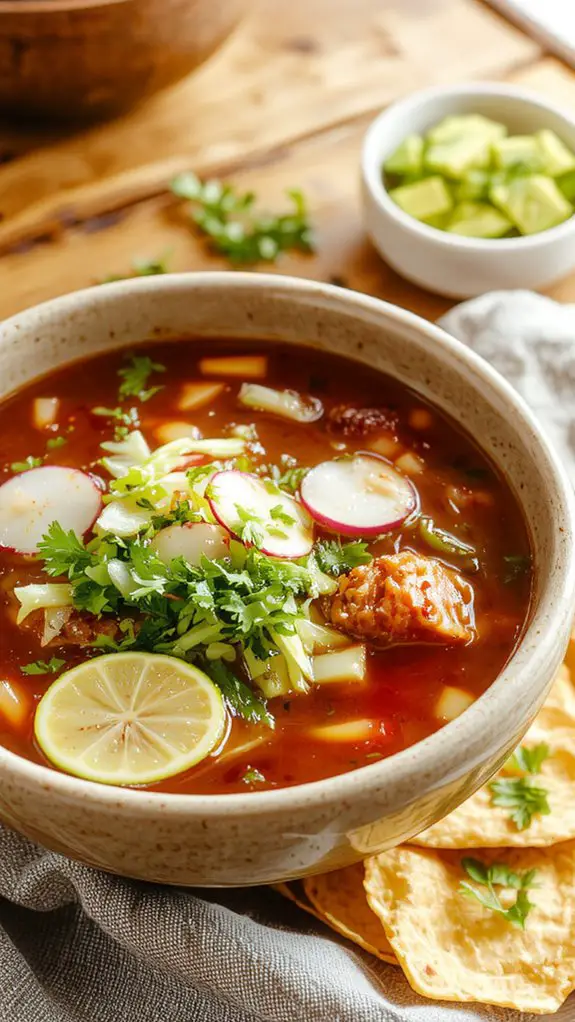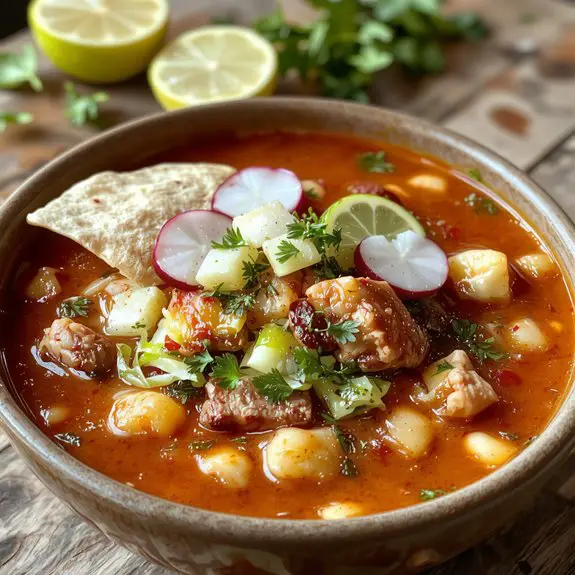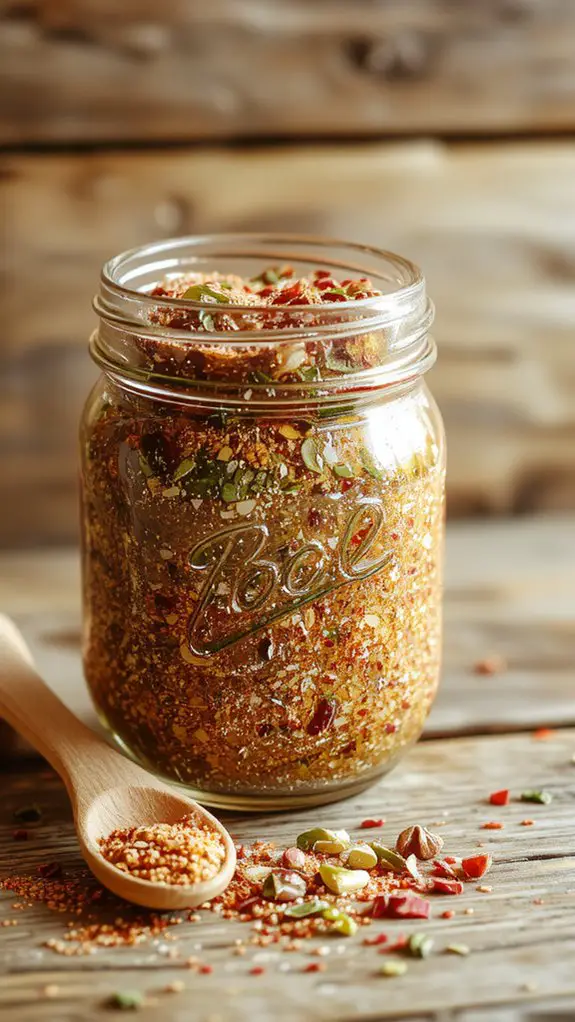Recipe
This homemade pozole recipe is the kind of dish you’ll want to make on repeat—it’s hearty, comforting, and packed with layers of flavor that will have everyone asking for seconds. What sets it apart? The slow-simmered broth, infused with smoky guajillo chiles and tender chunks of pork, creates a depth that store-bought versions just can’t match.
I’ve been perfecting this recipe for years, and it’s become a go-to for cozy nights and celebrations alike. The combination of hominy’s chewy texture, the richness of the broth, and the bright crunch of fresh toppings like radishes and cabbage make every bite a mini fiesta.
Trust me, once you try this, you’ll never look at canned pozole the same way again. Let’s get cooking—this is your ticket to a bowl of pure satisfaction.
Ingredients
The key to a truly unforgettable pozole lies in the quality of its ingredients. Each component brings depth, flavor, and authenticity to this hearty Mexican stew. While some elements are non-negotiable, there’s room for flexibility to make it your own. Here’s what you’ll need:
For the Broth and Meat:
Bereits ein schönes Bild in Arbeit.
- Pork shoulder or butt (2-3 lbs): The meat is the heart of pozole—its slow-cooked tenderness and rich flavor are irreplaceable.
- Hominy (2 cans, 29 oz each): Use white or yellow hominy for that signature chewy texture. If fresh hominy is available, even better.
- Guajillo or ancho chiles (4-6): These dried chiles create the base of the red sauce, offering a smoky, slightly sweet flavor. Pasilla chiles can work as a substitute.
- Garlic (6 cloves): Fresh garlic is a must for building layers of flavor.
- Onion (1 large): Yellow or white onions add sweetness and balance.
- Bay leaves (2): They infuse the broth with a subtle earthy aroma.
For the Sauce:
- Tomatoes (2 medium): Fresh tomatoes add brightness to the sauce. Roma tomatoes are ideal but canned tomatoes work in a pinch.
- Cumin (1 tsp): A touch of cumin deepens the flavor profile.
- Oregano (1 tsp): Use Mexican oregano if possible—its citrusy notes are essential.
For Serving:
- Cabbage (1/2 head): Finely shredded cabbage adds a revitalizing crunch.
- Radishes (1 bunch): Thinly sliced for a peppery bite.
- Lime wedges: Freshly squeezed lime juice brightens every bowl.
- Cilantro: A handful of chopped cilantro brings vibrancy.
- Avocado (optional but recommended): Creamy avocado slices elevate the dish.
- Tortillas or tostadas: Perfect for scooping up every last bite.
Pro Tips:
- For a richer broth, add pork bones or use chicken broth as a base.
- Toast the chiles lightly before blending for a deeper, smokier flavor.
- Don’t skip the garnishes—they’re not just for looks; they’re essential for the full pozole experience.
How to Make the Best Authentic Pozole Instructions

– Prepare the chiles: Remove stems and seeds from dried chiles, then toast them lightly in a dry skillet to deepen their flavor. Soak them in hot water for 15 minutes to soften.
Blend with garlic and a bit of soaking liquid until smooth, then strain to remove any grit. This forms the flavorful base of the pozole.
– Cook the pork: Cut pork shoulder into large chunks and simmer in a large pot with water, onion, garlic, and a bay leaf. Skim off any foam that rises to the top to keep the broth clear.
Cook for 1.5-2 hours until the meat is tender. This slow cooking guarantees rich, melt-in-your-mouth pork.
– Prepare the hominy: Drain and rinse canned hominy, then add it to the pot with the pork once the meat is tender.
Simmer for another 20-30 minutes to allow the flavors to meld. Hominy adds a unique texture and heartiness to the dish.
– Combine and season: Stir the blended chile sauce into the pot with the pork and hominy. Season with salt and let it simmer gently for another 15 minutes.
Taste and adjust seasoning as needed—this is your chance to perfect the balance of flavors.
– Serve with toppings: Ladle the pozole into bowls and let everyone customize with toppings like shredded cabbage, diced onion, radishes, lime wedges, oregano, and crushed tortilla chips.
Toppings add freshness and crunch, making each bite exciting.
- Pro tip: For a shortcut, use pre-cooked hominy and pre-made chile sauce, but adjust seasoning carefully since store-bought versions vary in flavor intensity.
- Watch out: Don’t skip straining the chile sauce—gritty pozole is no fun.
Also, avoid boiling the pozole vigorously after adding the chile sauce, as it can dull the flavors.
Nutrition
Pozole is a nutritious and hearty dish, packed with essential vitamins and minerals. Here’s the nutritional breakdown per serving:
| Nutrient | Amount per Serving |
|---|---|
| Calories | 350 kcal |
| Protein | 25 g |
| Carbohydrates | 30 g |
| Fat | 10 g |
| Fiber | 5 g |
| Sodium | 800 mg |
| Vitamin C | 15 mg |
| Iron | 3 mg |
Chef Tips
Cooking pozole’s all about layering flavors, and I always start by toasting the dried chiles gently—it really deepens their richness.
I simmer the hominy until it’s tender but still chewy, then skim the broth to keep it clear.
Letting the stew rest overnight intensifies the taste.
Finally, I serve it with crisp radishes, lime wedges, and cilantro for brightness.
Frequently Asked Questions
Can I Use Canned Hominy Instead of Dried?
Yes, I can use canned hominy instead of dried—it’s much quicker and easier. I’ll just rinse and drain it well before adding it to the pozole. It’ll still give that authentic taste without the extra prep time.
How Long Does Pozole Last in the Fridge?
Pozole lasts about 3-4 days in the fridge if I store it in an airtight container. I make sure it’s cooled before refrigerating, and I always reheat it thoroughly before eating to keep it safe and fresh.
Can I Freeze Leftover Pozole?
Yes, I can freeze leftover pozole, and it works well. I’d store it in airtight containers or freezer bags, leaving space for expansion. Thawing overnight in the fridge guarantees it keeps its texture and flavor.
What Are the Best Toppings for Pozole?
I love topping my pozole with shredded cabbage, radishes, and lime wedges, but I’ll also add avocado, cilantro, and a sprinkle of oregano. Sometimes I’ll toss in some diced onion or chili flakes for extra flavor.
Is Pozole Gluten-Free?
I can tell you pozole’s usually gluten-free since it’s made with hominy, meat, and broth—just check your spices and toppings. If I’m unsure, I’ll ask about additives or use certified gluten-free ingredients to stay safe.










